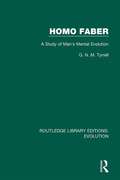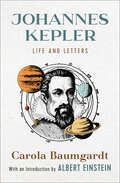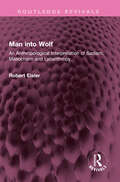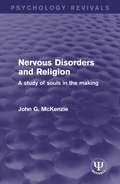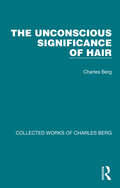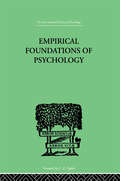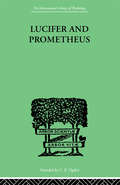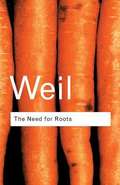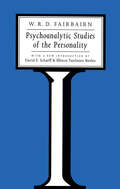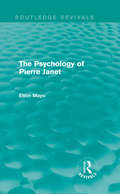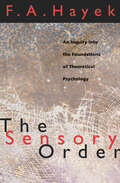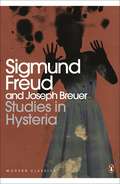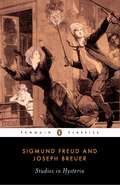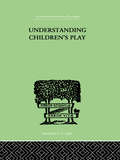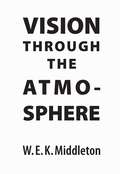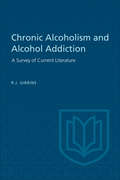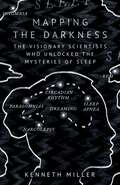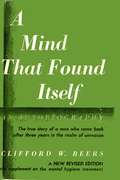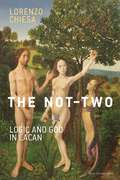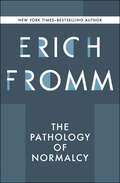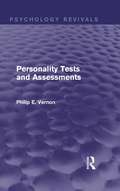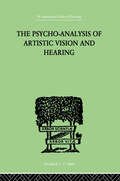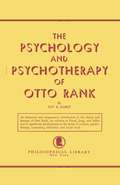- Table View
- List View
Homo Faber: A Study of Man's Mental Evolution (Routledge Library Editions: Evolution #14)
by G. N. TyrrellOriginally published in 1951, Homo Faber is an examination of the scientific outlook on human mental evolution through the lens of parapsychology. The book aims to undermine what its terms, the ‘scientific outlook’ examining the human interpretation of the world, and the preconceived scientific concepts that reality does not extend beyond the realm that our senses reveal. The book expands upon this and moves to examine the broader human understanding of the entire cosmos, challenging the scientific conception that this can be grasped in principal by human intellect, arising from the chance combination of material particles. The book argues that the scientific outlook prevents humans from discovering in the Universe the meaning and purpose which are everywhere to be found if sought in the appropriate contemplative states of mind. This book provides a unique take on the examination of human psychology and the evolution of the brain from an alternative scientific stance. It will be of interest to anthropologists, historians and psychologists alike.
Johannes Kepler: Life and Letters
by Carola BaumgardtWith an introduction by Albert Einstein: The collected letters of the Renaissance astronomer who discovered the laws of planetary motion. Astronomer and mathematician Johannes Kepler made major contributions to the Scientific Revolution of the seventeenth century. While his achievements are well-documented elsewhere, this volume of his personal correspondence offers a rare window into the life of a man who pursued knowledge through a dangerous and turbulent period of history. Spanning more than thirty years, from 1596 to the end of his life, Kepler&’s letters reveal the internal conflicts of a devout Protestant who nevertheless opposed many pronouncements of the Church, an eminent man of science who was also swayed by astrology, and a contemporary of Galileo who served three succeeding Holy Roman Emperors.
Man into Wolf: An Anthropological Interpretation of Sadism, Masochism and Lycanthropy (Routledge Revivals)
by Robert EislerFirst published in 1951, Man into Wolf attempts to suggest the possibility of historical, or rather prehistorical, evolutionist derivation of all crimes of violence, from the individual attack on life known as murder or manslaughter to the collective organized killing which we call war. The author has tried to show that the evidence from prehistory can be made intelligible on the theory of Jung’s archetypes surviving in the collective conscience and revealing themselves all over the world in legends, myths and rites. He discusses, in the notes on the lecture, every possible aspect of the subject ranging from the perverseness of the Marquis de Sade to the Grecian Bacchantes, and from the Green Men and the agricultural ceremonies to a case study of John George Haigh. This book will be of interest to students of anthropology, gender studies, and psychology.
Nervous Disorders and Religion: A Study of Souls in the Making (Psychology Revivals)
by John G. McKenzieOriginally published in 1951, this title is a study in developmental psychology with special reference to the effect of various types of religion on mental health and religious experience. With instinct as a ‘disappearing category’ in the psychology of human nature, a new approach to the realization of a harmonious interior life has been made using a doctrine of biological and personality needs as a starting point. Human nature is acquired and is not a static datum. The interior conflicts, the development of conscience and the origin of guilt feeling, the morbid complexes and the character-trends resulting from these conflicts with their sense of guilt are all studied. A long chapter on the various methods of mental healing through the doctrines of psycho-somatic medicine, with a new approach to Spiritual Healing in particular, prepares the way for the final chapter on the types of religion which originate or accentuate psychological conflicts, and the kind of religion which leads to a basic sense of security and harmonious personality. The illustrations are nearly all taken from Dr McKenzie’s own thirty years’ experience of dealing with neurotic disorders. This volume contains the substance (greatly expanded) of the Tate lectures delivered in Manchester College, Oxford, in 1947, and repeated at the St Andrews Summer School of Theology in1948 and at Iona Community.
The True Believer: Thoughts on the Nature of Mass Movements
by Eric HofferTalks about mass movements and human irrationality.
The Unconscious Significance of Hair: A Sort Of Autobiography (Collected Works of Charles Berg)
by Charles BergOriginally published in 1951, the implications of this book were thought to be far wider and deeper than its title suggests. 'Hair-activities are chosen merely as a sample of uncritically accepted human behaviour. The author then proceeds to examine them very carefully in the light of dreams, anthropology, folklore, symptoms and perversions. He shows them to be an expression of instinct-driven tensions and conflicts. The popular illusion that they are determined by reason or adaption to reality is exploded. The corollary is inescapable; if in this innocent particular our thoughts and behaviour are symptomatic expressions of an unconscious conflict or complex, how much more psychopathic would our more significant ideas, beliefs, institutions, customs and laws prove to be on similar detailed investigation! Is, therefore, our self-expression in life and civilization nothing more than a symptom, identical in its source and mechanism with the symptoms of nervous and mental illness? The book is really a psychiatric criticism of normality based upon a chosen item of typically normal behaviour. It is, however, written in a way that will be easily understood by every intelligent reader.' This book is a re-issue originally published in 1951. The language used is a reflection of its era and no offence is meant by the Publishers to any reader by this re-publication.
Empirical Foundations Of Psychology (International Library Of Psychology Ser.)
by Pronko, N H & Bowles, J WFirst published in 1999. Routledge is an imprint of Taylor & Francis, an informa company.
Lucifer and Prometheus: A STUDY OF MILTON'S SATAN
by R J WERBLOWSKYRoutledge is now re-issuing this prestigious series of 204 volumes originally published between 1910 and 1965. The titles include works by key figures such asC.G. Jung, Sigmund Freud, Jean Piaget, Otto Rank, James Hillman, Erich Fromm, Karen Horney and Susan Isaacs. Each volume is available on its own, as part of a themed mini-set, or as part of a specially-priced 204-volume set. A brochure listing each title in the "International Library of Psychology" series is available upon request.
The Need for Roots: Prelude to a Declaration of Duties towards Mankind
by Arthur Willis Simone WeilHailed by Andre Gide as the patron saint of all outsiders, Simone Weil's short life was ample testimony to her beliefs. In 1942 she fled France along with her family, going firstly to America. She then moved back to London in order to work with de Gaulle. Published posthumously The Need for Rootswas a direct result of this collaboration. Its purpose was to help rebuild France after the war. In this, her most famous book, Weil reflects on the importance of religious and political social structures in the life of the individual. She wrote that one of the basic obligations we have as human beings is to not let another suffer from hunger. Equally as important, however, is our duty towards our community: we may have declared various human rights, but we have overlooked the obligations and this has left us self-righteous and rootless. She could easily have been issuing a direct warning to us today, the citizens of Century 21.
Psychoanalytic Studies of the Personality
by W. R. FairbairnFirst published in 1952, W.R.D. Fairbairn's Psychoanalytic Studies of the Personality re-oriented psychoanalysis by centering human development on the infant's innate need for relationships, describing the process of splitting and the internal dynamic relationship between ego and object. His elegant theory is still a vital framework of psychoanalytic theory and practice, infant research, group relations and family therapy.This classic collection of papers, available for the first time in paperback, has a new introduction by David Scharff and Elinor Fairbairn Birtles which sets Fairbairn's highly original work in context, provides an overview of object relations theory, and traces modern developments, launched by Fairbairn's discoveries.
The Psychology of Pierre Janet (Routledge Revivals)
by Elton MayoPierre Janet (1859 – 1947) is considered to be one of the founders of psychology, and pioneered research in the disciplines of psychology, philosophy and psychotherapy. Janet’s most crucial research, particularly in the subjects of ‘dissociation’ and ‘subconscious’ - terms coined by him - is explored in this book, first published in 1952. As Janet did not publish much in English, these notes provide guidance on such areas of study as hysteria and hypnosis, obsessive thinking and the psychology of adaption. Elton Mayo’s comprehensive collection is an important guide for any student with an interest in the history of psychology, psychopathology and social study, and Janet’s revolutionary work in the field.
The Sensory Order: An Inquiry into the Foundations of Theoretical Psychology
by F. A. HayekThe Nobel Prize-winning economist explores how the mind works—an early landmark in the field of cognitive science. The Sensory Order, first published in 1952, sets forth F. A. Hayek's classic theory of mind in which he describes the mental mechanism that classifies perceptions that cannot be accounted for by physical laws. Though Hayek is more commonly known as an icon in the field of economics, his genius was wide-ranging—and his contribution to theoretical psychology is of continuing significance to cognitive scientists as well as to economists interested in the interplay between psychology and market systems, and has been addressed in the work of Thomas Szasz, Gerald Edelman, and Joaquin Fuster. &“A most encouraging example of a sustained attempt to bring together information, inference, and hypothesis in the several fields of biology, psychology, and philosophy.&”—Quarterly Review of Biology
Studies in Hysteria (Penguin Modern Classics)
by Sigmund FreudThe tormenting of the body by the troubled mind, hysteria is among the most pervasive of human disorders - yet at the same time it is the most elusive. Freud's recognition that hysteria stemmed from traumas in the patient's past transformed the way we think about sexuality. Studies in Hysteria is one of the founding texts of psychoanalysis, revolutionizing our understanding of love, desire and the human psyche.
Studies in Hysteria
by Sigmund Freud Josef BreuerHysteria—the tormenting of the body by the troubled mind—is among the most pervasive of human disorders; yet, at the same time, it is the most elusive. Freud’s recognition that hysteria stemmed from traumas in the patient’s past transformed the way we think about sexuality. Studies in Hysteria is one of the founding texts of psychoanalysis, revolutionizing our understanding of love, desire, and the human psyche. As full of compassionate human interest as of scientific insight, these case histories are also remarkable, revelatory works of literature. .
Understanding Children'S Play
by Ruth E. Hartley Lawrence K. Frank Robert GoldensonFirst Published in 1999. Routledge is an imprint of Taylor & Francis, an informa company.
Vision Through the Atmosphere (Heritage)
by W.E.K. MiddletonIn recent years, the problem of seeing through the atmosphere has been given intensive and costly consideration in several quarters, but particularly in the Untied States and Great Britain. A problem which once concerned mainly the meteorologists has become of great importance in military tactics as well as in peacetime transportation. The present volume is the only full account in English of the physical, physiological, and psychological factors which lie at the basis of the calculation of the range of vision through the atmosphere. There is an extended chapter on instruments and one on the author's own theory of the colours of distant objects. The figures are from many sources althrough many of them have been drawn specially for this book. The bibliography contains 420 entries nearly all of which are directly referred to in the text.
Character and Social Structure: The Psychology of Social Institutions
by Hans Gerth C. Wright MillsThis book is a fully rounded synthesis which incorporates all the major conceptions of psychology and sociology that bear upon the formation of character and personality in the context of social structure.
Chronic Alcoholism and Alcohol Addiction
by R. J. Gibbins B. W. Henheffer A. RaisonThis book is a survey of current literature on chronic alcoholism and alcohol addiction. The authors are interested, however, not only in those individuals who are unable to give up alcohol (i.e. the addicts), but also in the more numerous abnormal drinkers all of whom are potential secondary addicts, who have developed a physiological and ultimately also a psychological need in the proceed of habituation, but in whose management of life alcohol has not played an essentially dominant role.
Mapping the Darkness: The Visionary Scientists Who Unlocked the Mysteries of Sleep
by Kenneth MillerThirty-two days underground. No heat. No sunlight. 4 June 1938. Nathaniel Kleitman and his research student make their way down the seventy-one steps leading to the mouth of Mammoth Cave. They are about to embark on one of the most intrepid and bizarre experiments in medical history, one which will change our understanding of sleep forever. Undisturbed by natural light, they will investigate what happens when you overturn one of the fundamental rhythms of the human body. Together, they enter the darkness. When Kleitman first arrived in New York, a penniless twenty-year-old refugee, few would have guessed that in just a few decades he would revolutionise the field of sleep science. In Mapping the Darkness, Kenneth Miller weaves science and history to tell the story of the outsider scientists who took sleep science from the fringes to a mainstream obsession. Reliving the spectacular experiments, technological innovation, imaginative leaps and single-minded commitment of these early pioneers, Miller provides a tantalising glimpse into the most mysterious third of our lives.
A Mind that Found Itself: An Autobiography (classic Reprint)
by Clifford Whittingham BeersA Mind That Found Itself by Clifford Whittingham Beers, is derived from as human a document as ever existed; and, because of its uncommon nature, perhaps no one thing contributes so much to its value as its authenticity. It is an autobiography, and more: in part it is a biography; for, in telling the story of the authors life, which he must relate the history of another self-a self which was dominant from his twenty-fourth to twenty-sixth year. During that period, unlike he had ever been been, or what he has been since. The biographical part of his autobiography might be called the history of a mental civil war, which he fought single-handed on a battlefield that lay within the compass of his skull.
The Not-Two: Logic and God in Lacan
by Lorenzo ChiesaIn The Not-Two, Lorenzo Chiesa examines the treatment of logic and God in Lacan's later work. Chiesa draws for the most part from Lacan's Seminars of the early 1970s, as they revolve around the axiom "There is no sexual relationship." Chiesa provides both a close reading of Lacan's effort to formalize sexual difference as incompleteness and an assessment of its broader implications for philosophical realism and materialism.Chiesa argues that "There is no sexual relationship" is for Lacan empirically and historically circumscribed by psychoanalysis, yet self-evident in our everyday lives. Lacan believed that we have sex because we love, and that love is a desire to be One in face of the absence of the sexual relationship. Love presupposes a real "not-two." The not-two condenses the idea that our love and sex lives are dictated by the impossibility of fusing man's contradictory being with the heteros of woman as a fundamentally uncountable Other. Sexual liaisons are sustained by a transcendental logic, the so-called phallic function that attempts to overcome this impossibility. Chiesa also focuses on Lacan's critical dialogue with modern science and formal logic, as well as his dismantling of sexuality as considered by mainstream biological discourse. Developing a new logic of sexuation based on incompleteness requires the relinquishing of any alleged logos of life and any teleological evolution.For Lacan, the truth of incompleteness as approached psychoanalytically through sexuality would allow us to go further in debunking traditional onto-theology and replace it with a "para-ontology" yet to be developed. Given the truth of incompleteness, Chiesa asks, can we think such a truth in itself without turning incompleteness into another truth about truth, that is, into yet another figure of God as absolute being?
The Pathology of Normalcy
by Erich FrommThe legendary social psychologist and New York Times–bestselling author meditates on ideas of mental health and normalcy in contemporary society. At the beginning of the 1950s, Erich Fromm increasingly questioned whether people in contemporary industrial society were mentally healthy. Eventually the topic of various lectures, Fromm&’s new social psychoanalytic approach enabled him to further develop the psychoanalytic method into a comprehensive critique of the pathology of the &“normal,&” socially adjusted human being. He was thus able to subject to a radical analysis the widespread strivings that dominate behavior in society—and therefore question what is &“normal,&” what is beneficial to mental health, and what makes people ill. In The Pathology of Normalcy, Fromm examines the concepts of mental health and mental illness in modern society. He discusses, through a series of lectures, subjects including a frame of reference for evaluating mental health, the relationship between mental health issues and alienation, and the connection between psychological and economic theory. Finally, he elucidates how humanity can overcome &“the insane society,&” as well as its own innate laziness.
Personality Tests and Assessments (Psychology Revivals)
by Philip E. VernonOriginally published in 1953 this book provided the first comprehensive account of methods of personality assessment by a British author. It starts with a short survey of personality theory, pointing out the difficulties in any method of testing or assessment. Next it describes the weaknesses of the common interview method. (Throughout the emphasis is on methods which are usable in educational or vocational guidance and selection, not on methods which are mainly of scientific interest.) Thereafter it takes up each main type of technique – tests based on physique or psychological measures, on expressive movement such as gestures and handwriting, tests of behaviour (including War Office Selection Board ‘house party’ methods), ratings and rating scales, questionnaires, and so-called projective techniques. The evidence for or against each test or method is surveyed and numerous references provided for relevant literature. Illustrative excerpts are given of many of the more promising tests, and some pictorial illustrations. British work in this field at the time is covered completely, and an attempt is made to provide a fair summary of the main contributions of American and other psychologists of the day.
The Psycho-Analysis Of Artistic Vision And Hearing: An Introduction to a Theory of Unconscious Perception (International Library Of Psychology Ser. #Vol. 38)
by Ehrenzweig, AntonThis book deals with the inarticulate form elements hidden in the unconscious structure of a work of art or—what comes to the same thing — with the unconscious structure of the perception processes by which we actively create or passively enjoy these unconscious form elements. In order to become aware of inarticulate forms we have to adopt a mental attitude not dissimilar to that which the psycho-analyst must adopt when dealing with unconscious material, namely some kind of diffuse attention.
The Psychology and Psychotherapy of Otto Rank: An Historical and Comparative Introduction
by Fay B. KarpfOtto Rank, an Austrian psychologist, was a protege of Sigmund Freud, who saw in young Rank a gifted mind and drew him into his inner circle. The Psychology and Psychotherapy of Otto Rank is author Fay B. Karpf s historical and comparative introduction to the theory and therapy of Otto Rank, his relation to Freud, Jung, and Adler and to significant developments in the fields of analysis, psychotherapy, counseling, education, and social work. Fay B. Karpf was one of the earliest Jewish American woman sociologists. Born in Austria in 1893, Karpf eventually immigrated to the United States, where she attended the University of Chicago. She immersed herself in the Chicago School of Sociology, and her first book, American Social Psychology: Its Origins, Development and European Background (1932), was a standard textbook in the field of social psychology. She studied with the psychoanalyst Otto Rank, and she later taught social work at the Training School for Jewish Social Work in New York. After the school unfortunately closed, Karpf moved with her husband to Los Angeles, where she became a practicing counselor and psychotherapist, and she continued contributing to the fields until her death in 1981.
